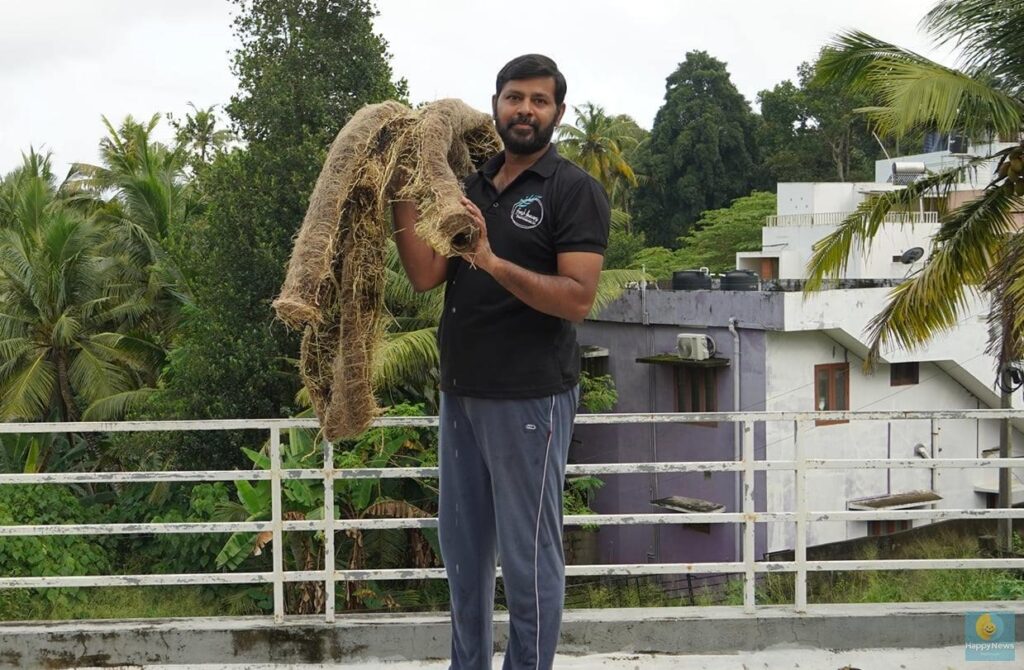Farming technology is a growing field in today’s era of high demand of quality food.
- Santhosh Kumar, a former IT professional, who is merging technology with traditional farming.
- His venture, “FreshLeaves,” uses hydroponic technology, reducing resource use and maximizing crop quality.
- Microcontrollers and software help him monitor and manage farm conditions remotely.
- Awarded for his innovation, Santhosh is reshaping farming in Kerala and inspiring tech-driven agriculture.

In the heart of Thiruvananthapuram, Kerala, Santhosh Kumar, a former IT professional with a background in user experience design, has embarked on a journey that few could imagine: using code in growing crops. Santhosh traded his career in software technology for a different kind of lab, one where he doesn’t design digital interfaces but cultivates plants in a high-tech greenhouse. Through his venture, FreshLeaves, Santhosh is introducing hydroponic farming technology to Kerala and changing the farming landscape.
From IT Professional to Hydroponic Farmer
Santhosh Kumar, a former IT specialist and user experience (UX) designer, left his tech career to pursue farming, inspired by a desire to bring modern solutions to age-old practices. With a deep-rooted passion for sustainable agriculture, Santhosh founded “FreshLeaves,” a farm that incorporates advanced farming technology to improve crop production and reduce environmental impact. His journey from IT to agriculture is a testament to the versatility of farming technology and how it’s empowering professionals from diverse fields to reshape the agricultural landscape.
After years in the tech industry, Santhosh found himself longing for something more grounded. His fascination with sustainable farming and modern agriculture sparked the idea for FreshLeaves, a farm that utilizes hydroponics—a soil-free method of growing plants in nutrient-rich water solutions. This high-tech approach appealed to Santhosh, allowing him to combine his love for technology with his newfound passion for farming. But his journey wasn’t just about leaving behind screens; it was about transforming traditional agriculture with the power of digital technology.
Embracing Farming Technology: From Code to Crops
Santhosh’s experience as a designer gave him the insight and problem-solving skills necessary to approach farming innovatively. Using microcontrollers and open-source software, Santhosh developed a unique system to manage his farm remotely. These technologies allow him to monitor and adjust vital factors such as nutrient delivery, pH levels, and lighting, ensuring each plant gets precisely what it needs at the right time. This meticulous control over growing conditions enhances crop quality while reducing resource waste.
In Santhosh’s words, “Farming may seem like a step away from technology, but for me, it’s a continuation of problem-solving—just with plants instead of programs.” His knowledge of coding has allowed him to automate several farming processes, making his operation efficient and scalable. For instance, the integration of Internet of Things (IoT) devices helps him track moisture and temperature, alerting him to any deviations in real-time, which he can address from anywhere with an internet connection.

Farming Technology in Action: Growing Microgreens and Exotic Plants with Hydroponics
At FreshLeaves, Santhosh focuses on hydroponics, a high-tech approach to farming that doesn’t require soil. Hydroponic systems are a cornerstone of farming technology, allowing plants to grow in nutrient-rich water solutions. This method uses up to 90% less water than traditional soil-based farming, tackling one of agriculture’s biggest challenges—water scarcity. Furthermore, hydroponics reduces the dependency on pesticides, as it minimizes soil-borne diseases.
By focusing on high-value crops like microgreens, Santhosh has turned FreshLeaves into a sustainable, low-impact farm that thrives on innovation. His hydroponic systems use up to 90% less water than traditional farming methods, addressing a major concern in agriculture: water scarcity. Additionally, hydroponics eliminates the need for soil, reducing the risk of soil-borne diseases and pests, which means less dependency on pesticides and herbicides.
Santhosh’s farm, FreshLeaves, specializes in microgreens and exotic plants—a decision driven by the increasing demand for these nutrient-dense and flavorful crops. Microgreens, often used by chefs for their intense flavor and nutritional benefits, require minimal land and water. This makes them ideal for hydroponic systems, which maximize efficiency and minimize environmental impact.
Recognized for Farming Technology and Innovation: The 2023 State Farm Award for Innovation in Kerala
Santhosh’s tech-driven approach to farming technology has not gone unnoticed. In 2023, he received the prestigious State Farm Award for Innovation in Kerala, acknowledging his contribution to the agricultural sector through technology. This accolade is a testament to the transformative power of blending technology with traditional practices.
For many, this award symbolizes the potential for tech professionals to contribute beyond the digital realm. Santhosh’s work inspires others to look at farming not just as an ancient practice but as an evolving field ripe for technological intervention.
Impact of Farming Technology on the Local Community and Beyond
Santhosh’s success has not only benefited him but also sparked interest in tech-driven agriculture within his community. His farm has become a model for sustainable farming using technology in urban areas, demonstrating how even small plots of land can yield high returns with the right technology. Santhosh frequently hosts workshops and educational programs, sharing his knowledge of hydroponics and IoT applications in farming to empower other aspiring farmers.
By integrating tech into agriculture, Santhosh is helping to create a more resilient, sustainable food system. His work showcases the potential of farming technology, encouraging young professionals and tech enthusiasts to view agriculture as a promising field that blends innovation with sustainability.

Conclusion: Using Technology in Farming
Santhosh Kumar’s journey from a UX designer to a hydroponic farmer embodies the spirit of innovation. By using technology to optimize his farm, he’s not only cultivating crops but also planting seeds of change in the agricultural sector. FreshLeaves is a testament to how merging tech skills with agricultural practices can redefine farming, making it efficient, sustainable, and accessible to a new generation of tech-savvy individuals.
With recognition from his state and the local community, Santhosh is paving the way for the future of farming with technology. His story shows that whether you’re working with code or crops, the impact of technology is boundless—and it has the power to transform even the oldest of industries.
By integrating farming technology into agriculture, Santhosh is paving the way for a new generation of farmers who view technology as an essential tool in solving today’s agricultural challenges. His story serves as a beacon for others, illustrating that farming technology isn’t just an add-on to traditional methods; it’s a game-changer, capable of transforming even the oldest industry.
Research Materials on this farming technology:
Hydroponics: current trends in sustainable crop production
Hydroponics for Home Growers : USDA
You may also like: How 3 Friends saved a Govt. School in Bengaluru, India
Similar Posts:
- Whole Grain Wonders: Healthy Foods for You and the Planet
 Switching to a whole grain diet not only revitalizes your health but also contributes to a healthier planet by using fewer … Read more
Switching to a whole grain diet not only revitalizes your health but also contributes to a healthier planet by using fewer … Read more - Rats with Backpacks: The New Heroes Against Smuggling
 Background Imagine a world where small, agile allies are employed to curb the illegal wildlife trade. In an unconventional twist, specially … Read more
Background Imagine a world where small, agile allies are employed to curb the illegal wildlife trade. In an unconventional twist, specially … Read more - Reasearch based top 6 tips on raising “Good Kids”
 Introduction Every parent’s dream is to raise children who are kind, responsible, and emotionally resilient. Harvard psychologists have examined what it … Read more
Introduction Every parent’s dream is to raise children who are kind, responsible, and emotionally resilient. Harvard psychologists have examined what it … Read more - Empowering Children with Dyslexia in Chennai: MDA
 Introduction In 1992, a compassionate group of parents, educators, and philanthropists came together to create the Madras Dyslexia Association (MDA). Their … Read more
Introduction In 1992, a compassionate group of parents, educators, and philanthropists came together to create the Madras Dyslexia Association (MDA). Their … Read more




